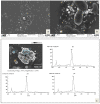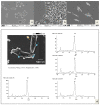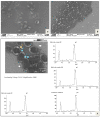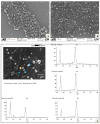Formation of Se (0) nanoparticles by Duganella sp. and Agrobacterium sp. isolated from Se-laden soil of North-East Punjab, India
- PMID: 22607265
- PMCID: PMC3391978
- DOI: 10.1186/1475-2859-11-64
Formation of Se (0) nanoparticles by Duganella sp. and Agrobacterium sp. isolated from Se-laden soil of North-East Punjab, India
Abstract
Background: Selenium (Se) is an essential trace element, but is toxic at high concentrations. Depending upon the geological background, the land use or on anthropogenic pollution, different amounts of Se may be present in soil. Its toxicity is related to the oxyanions selenate and selenite as they are water soluble and bioavailable. Microorganisms play an important role in Se transformations in soil and its cycling in the environment by transforming water-soluble oxyanions into water insoluble, non-toxic elemental Se (0). For this study, soil samples were collected from selenium-contaminated agricultural soils of Punjab/India to enrich and isolate microbes that interacted with the Se cycle.
Results: A mixed microbial culture enriched from the arable soil of Punjab could reduce 230 mg/l of water soluble selenite to spherical Se (0) nanoparticles during aerobic growth as confirmed by SEM-EDX. Four pure cultures (C 1, C 4, C 6, C 7) of Gram negative, oxidase and catalase positive, aerobic bacteria were isolated from this mixed microbial consortium and identified by 16 S rDNA gene sequence alignment as two strains of Duganella sp. (C 1, C 4) and two strains of Agrobacterium sp.(C 6, C 7). SEM/TEM-EDX analyses of the culture broth of the four strains revealed excretion of uniformly round sharply contoured Se (0) nanoparticles by all cultures. Their size ranged from 140-200 nm in cultures of strains C 1 and C 4, and from 185-190 nm in cultures of strains C 6 and C 7. Both Duganella sp. revealed better selenite reduction efficiencies than the two Agrobacterium sp.
Conclusions: This is the first study reporting the capability of newly isolated, aerobically growing Duganella sp. and Agrobacterium sp. from soils of Punjab/India to form spherical, regularly formed Se (0) nanoparticles from water soluble selenite. Among others, the four strains may significantly contribute to the biogeochemical cycling of Se in soil. Bioconversion of toxic selenite to non-toxic Se (0) nanoparticles under aerobic conditions in general may be useful for detoxification of agricultural soil, since elemental Se may not be taken up by the roots of plants and thus allow non-dangerous fodder and food production on Se-containing soil.
Figures









Similar articles
-
Reduction of selenite to Se(0) nanoparticles by filamentous bacterium Streptomyces sp. ES2-5 isolated from a selenium mining soil.Microb Cell Fact. 2016 Sep 15;15(1):157. doi: 10.1186/s12934-016-0554-z. Microb Cell Fact. 2016. PMID: 27630128 Free PMC article.
-
Se (IV) triggers faster Te (IV) reduction by soil isolates of heterotrophic aerobic bacteria: formation of extracellular SeTe nanospheres.Microb Cell Fact. 2014 Nov 26;13:168. doi: 10.1186/s12934-014-0168-2. Microb Cell Fact. 2014. PMID: 25425453 Free PMC article.
-
Two selenium tolerant Lysinibacillus sp. strains are capable of reducing selenite to elemental Se efficiently under aerobic conditions.J Environ Sci (China). 2019 Mar;77:238-249. doi: 10.1016/j.jes.2018.08.002. Epub 2018 Aug 17. J Environ Sci (China). 2019. PMID: 30573088
-
Unveiling the vital role of soil microorganisms in selenium cycling: a review.Front Microbiol. 2024 Sep 11;15:1448539. doi: 10.3389/fmicb.2024.1448539. eCollection 2024. Front Microbiol. 2024. PMID: 39323878 Free PMC article. Review.
-
Microbial Transformations of Selenium Species of Relevance to Bioremediation.Appl Environ Microbiol. 2016 Jul 29;82(16):4848-59. doi: 10.1128/AEM.00877-16. Print 2016 Aug 15. Appl Environ Microbiol. 2016. PMID: 27260359 Free PMC article. Review.
Cited by
-
Technological Microbiology: Development and Applications.Front Microbiol. 2017 May 10;8:827. doi: 10.3389/fmicb.2017.00827. eCollection 2017. Front Microbiol. 2017. PMID: 28539920 Free PMC article. Review.
-
Reduction of selenite to Se(0) nanoparticles by filamentous bacterium Streptomyces sp. ES2-5 isolated from a selenium mining soil.Microb Cell Fact. 2016 Sep 15;15(1):157. doi: 10.1186/s12934-016-0554-z. Microb Cell Fact. 2016. PMID: 27630128 Free PMC article.
-
Tellurium: A Rare Element with Influence on Prokaryotic and Eukaryotic Biological Systems.Int J Mol Sci. 2021 May 31;22(11):5924. doi: 10.3390/ijms22115924. Int J Mol Sci. 2021. PMID: 34072929 Free PMC article. Review.
-
Selenite Reduction and the Biogenesis of Selenium Nanoparticles by Alcaligenesfaecalis Se03 Isolated from the Gut of Monochamus alternatus (Coleoptera: Cerambycidae).Int J Mol Sci. 2018 Sep 17;19(9):2799. doi: 10.3390/ijms19092799. Int J Mol Sci. 2018. PMID: 30227664 Free PMC article.
-
Electroactive Brevundimonas diminuta consortium mediated selenite bioreduction, biogenesis of selenium nanoparticles and bio-electricity generation.J Nanobiotechnology. 2024 Jun 20;22(1):352. doi: 10.1186/s12951-024-02577-3. J Nanobiotechnology. 2024. PMID: 38902695 Free PMC article.
References
-
- Institute of Medicine, Food and Nutrition Board. Dietary Reference Intakes: Vitamin C, Vitamin E, Selenium, and Carotenoids. Washington DC, National Academy Press. 2000.
-
- Plant JA, Kinniburgh DG, Smedley PL, Fordyce FM, Klinck BA. Arsenic and selenium. In Environmental Geochemistry, Treatise on Geochemistry. Volume 9. Edited by Lollar BS. Amsterdam/Heidelberg: Elsevier. 2005. pp. 17–66.
Publication types
MeSH terms
Substances
LinkOut - more resources
Full Text Sources
Other Literature Sources
Molecular Biology Databases

